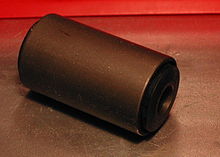This article needs additional citations for verification. (February 2010) |

A bushing or rubber bushing is a type of vibration isolator. It provides an interface between two parts, damping the energy transmitted through the bushing. A common application is in vehicle suspension systems, where a bushing made of rubber (or, more often, synthetic rubber or polyurethane[1]) separates the faces of two metal objects while allowing a certain amount of movement. This movement allows the suspension parts to move freely, for example, when traveling over a large bump, while minimizing transmission of noise and small vibrations through to the chassis of the vehicle. A rubber bushing may also be described as a flexible mounting or antivibration mounting.
These bushings often take the form of an annular cylinder of flexible material inside a metallic casing or outer tube. They might also feature an internal crush tube which protects the bushing from being crushed by the fixings which hold it onto a threaded spigot. Many different types of bushing designs exist. An important difference compared with plain bearings is that the relative motion between the two connected parts is accommodated by strain in the rubber, rather than by shear or friction at the interface. Some rubber bushings, such as the D block for a sway bar, do allow sliding at the interface between one part and the rubber.